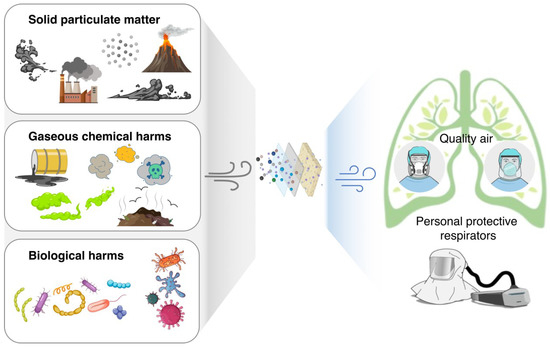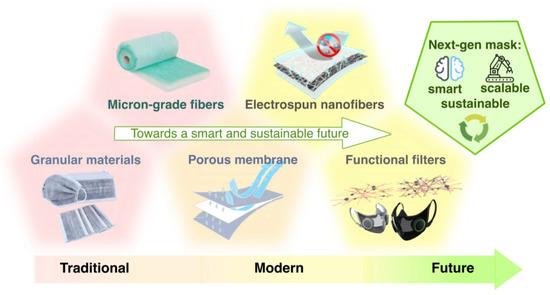Apart from the filtration capability, as the fundamental function of a mask, there are many more roles and applications a mask can fit to fulfil complex application requirements when introduced expanded features and additional functionalities from healthcare, sports tracking, fashion and military applications. Developing new functionalities for wearables, including smart masks, has become a new trend and has the potential to revolutionize the role these devices play in our daily life, reflected by the heated focus on self-cleaning, sensing, actuating and communicating through introducing new materials, structures and nano-coatings [
101,
102,
103]. Many bulky machines and cumbersome wires connect them for communication, which substantially limits patient’s mobility. Not only for the comfort of the person under test, to accurately reflect the medical condition of the object also requires a continuous monitoring session to track signals in real time. Thus, a personalized portable device is needed to seamlessly monitor the physiological signals of the wearer. Tailoring polymeric fibrous filters with multi-functionalities has shown potential in numerous filtration applications. The properties of interest include toxic gas absorption, antibacterial film, anti-corrosive film, etc.
3.1. Intelligent and Green Wearables
For smart masks fulfilling the post-pandemic scheme and an intelligent future, there are versatile approaches to design and fabricate respirators that are integrated with smaller, portable or even personalized specific functional modules. At the same time, sustainable materials that are degradable, recyclable or environmentally friendly have caught more attention with increased awareness of developing a circular economy [
116,
117,
118], such as biodegradable and biocompatible materials [
98,
119,
120] especially for skin interface sensors. For example, biocompatible and environmentally friendly options including polydimethylsiloxane (PDMS) or multiscale porous polystyreneblock-poly(ethylene-ran-butylene)-block-polystyrene (SEBS) as substrates, hydrophobic poly(3,4-ethylenedioxythiophene):poly(styrenesulfonate) (PEDOT:PSS) and AgNWs as conductive materials are particularly suitable for wearable electronic applications [
121,
122,
123,
124]. Therefore, it is vital to have the principle of sustainable development as a frame within which to derive wearable design.
3.2. Macroscopic Physiological Signal Monitoring
roaches are desirable for physiological signal monitoring [
125]. Apart from conventional clinical practice that provides health characterization at considerable cost, wearable systems have great potential thanks to their cost-effective nature and continuous utility [
101,
126,
127]. In fact, a wide range of biosignals generated around the face area are eligible to be captured, observed and analyzed by mask. For general health care monitoring purposes, a set of biosignals on a macroscopic level captured by appropriate sensors attached/integrated in masks serves as an indicator of the health status of the wearer. These captured signals, such as heart rate, respiratory rate and blood oxygen saturation (SpO
2) level, require subsequent processes to interpret and explain. This makes smart masks incorporated with sensors that react to biosignals or environmental stimuli as wearable healthcare possible [
128]. A miniaturized system is preferred due to the relatively limited area for sensor implementation on the mask, while integrating machine learning techniques for the analytical evaluation of complex relationships [
129,
130,
131] is another approach.
Respiration rate, together with blood pressure, body temperature and heart rate, are decisive physiological signals that reflect the object’s health condition. Respiratory detection with rate and depth information is a vital metric and provides diagnostic reference for health status estimation of patients that irregularities in respiratory patterns can be a predictor of potentially grievous clinical events [
132,
133], or an indicator to characterize illness such as obstructive apneas for Parkinson’s disease [
134]. With face masks covering the wearer’s noses, it is undoubtedly convenient to acquire respiratory information. The locations of the integrating sensors on the masks directly determine the sensing functionality.
For mask applications, it is often expected that the mask will serve as a strain or tactile sensor that is attached or integrated to itself and, at the same time, conformable and comfortable for the user to wear. In these cases, the user’s activities, such as breathing or coughing, introduce a change in the air pressure within the wearer and mask, resulting in tiny movement or deformation. The movements captured are the stimuli. For example, Li et al. developed a piezoresistive sensor for masks composed of MXene-coated tissue paper that responds to pressure changes induced by human movements [
135].
On the other hand, face masks can sense and reflect environmental information from air quality, and environmental temperature to humidity level surrounds the user as well. For instance, Escobedo et al. proposed a wireless gaseous CO
2 level detector deposited on a flexible tag that sticks to the inner side of a standard FFP2 facemask [
137]. The developed CO
2 sensor works with the mechanism that the acid–base indicator inflects the luminescence level of an inorganic phosphor La
2O
2S:Eu, and with UV LED and color sensor, the acidity of gaseous CO
2 is indicated. The sensing module together with UV LED, color detector, temperature sensor and supporting circuits were printed on a flexible polyethylene terephthalate (PET) substrate. Apart from CO
2 level, face masks with temperature or humidity sensing capabilities are developed by researchers as well. Firat et al. developed a respiration sensor based on cellulose paper, with printed graphite as electrodes and attached in a surgical mask, in response to humidity level change [
138].
3.3. Disease Diagnosis and Monitoring
Bio-integrated wearable devices offer economic characterization, portable health care analysis, and continuous monitoring are suited to fill in gaps in conventional medical practice [
125]. For example, mask-based wearables for glucose monitoring [
32] where metal nanowires with enzyme modified electrodes for H
2O
2 and glucose sensing, and other types of nanowire modified electrodes for different types of sensors for chemical sensors and biosensors [
79]. Physiological signals captured by smart masks offer a convenient approach for disease diagnosis and monitoring, and when equipped with biosensors, they are specifically suitable for respiratory diseases such as COVID-19 since the evidence of abnormal breathing patterns reflects directly on masks. Nguyen et al. reported a biomolecule detection embedded on a facemask with synthetic biology sensors that provides SARS-CoV-2-sensing though freeze-dried reactions on a microfluidic paper-based analytical device, which prototype rapidly and feasible to regulate optimization of the multi-step reactions [
140]. When the virus accumulates in the mask with the patients’ respiratory behavior and flows through the puncture of the water blister reservoir, viral particles are transported from the collection sample pad to the microfluidic paper-based analytical device downstream due to capillary action. The three reaction zones are separated by PVA to ensure sufficient time delay for incubation. After lyophilized lysis reagents, isothermal amplification targeting for a nonoverlapping region of the SARS-CoV-2 S gene and amplified dsDNA amplicon detection, a lateral flow assay strip visualized the results. Notably, this mask-based biosensor doesn’t require laboratory equipment or specialists like other nucleic acid testing demands; it operates on an autonomous base and offers safe, efficient testing without further concerns.


